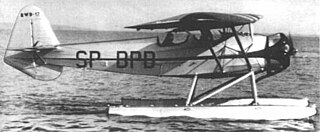Related Research Articles

The SAI KZ III Lærke ("lark") was a Danish light utility aircraft used by the Danish Air Ambulance Service and Danish Air Force.

The RWD 17 was a Polish aerobatics-trainer aircraft of 1937, parasol wing monoplane, constructed by the RWD team.

The VEF I-12 was a tandem, two-seat Latvian trainer aircraft designed by Kārlis Irbītis and produced by VEF in Riga.

The General Aircraft GAL.42 Cygnet II was a 1930s British single-engined training or touring aircraft built by General Aircraft Limited at London Air Park, Hanworth.

The Miles M.28 Mercury was a British aircraft designed to meet the need for a training and communications plane during the Second World War. It was a single-engined monoplane of wooden construction with a twin tail and a tailwheel undercarriage with retractable main units.
The Arpin A-1 was a two-seat low-wing monoplane which was powered by a single radial engine in pusher configuration, mounted behind the cabin between twin booms that carried the tail. An unconventional fixed tricycle undercarriage was fitted. Only one was built.

The B.A Swallow was a British light aircraft of the 1930s. It was a license-built version by the British Klemm Aeroplane Company of the German Klemm L.25. A total of 135 were built.

The Miles Hawk Major was a 1930s British two-seat light monoplane, developed by Miles Aircraft from the Miles Hawk in order to take advantage of the new inverted de Havilland Gipsy Major engine. When fitted with the longer Gipsy Six in place of the forward crew member, it was known as the Miles Hawk Speed Six.

The Elliotts of Newbury EoN or Elliotts EoN A.P.4 was a 1940s British four-seat touring monoplane aircraft built by Elliotts of Newbury.

The Miles M.65 Gemini was a British twin-engined four-seat touring aircraft designed and built by Miles Aircraft at Woodley Aerodrome. It was the last Miles aircraft to be produced in quantity.

The RWD 23 was a Polish low-wing trainer aircraft of 1938, constructed by the RWD team, that remained a prototype.

The Miles M.18 was a single-engine twin-seat low-winged light British civil utility aircraft of the 1930s.

The Miles M.68 was a 1947 attempt to produce a containerised freighter aircraft by the modification of the Miles Aerovan. The container or air-trailer was part of the fuselage but could be dismounted and towed on the road.
The Deekay Knight was a British two-seat cabin monoplane designed by S.C.Hart-Still and built in 1937 by the Deekay Aircraft Corporation at Broxbourne in Hertfordshire, England. It was built to test methods of wing construction that would later be suitable for plastic skinning.
The Portsmouth Aerocar was a British light utility aircraft design of the late 1940s. It was intended to be an aircraft that could be used for a variety of tasks including transport "mobile office" but only one prototype was built being scrapped in 1950.

The Stout Skycar is a series of four one-off American light aircraft of the 1930s.
The Marendaz Trainer was a two-seat low-wing training aircraft built in the UK just before World War II. Only one was completed.
The Pasotti F.6 Airone was a low-wing, twin-engined, wooden, four seat civil aircraft built in Italy in the 1950s. Production was considered but only one was completed.
The Hillson Helvellyn was a 1940s British two-seat training monoplane designed by Norman Sykes and built by F Hills & Sons of Trafford Park.

The Caproni Ca.193 was an Italian liaison and air-taxi aircraft that was offered to the Italian Air Force as an instrument flight trainer and to the Navy for liaison. Design work started in 1945 and only the prototype was built. It was the last aircraft the Caproni company designed and built in Milan.
References
- General Aircraft Cagnet – British Aircraft of World War II